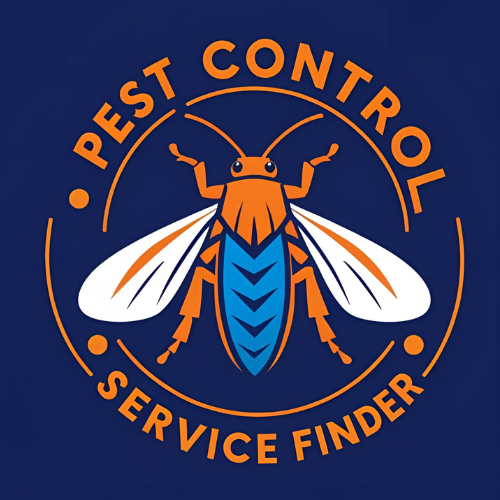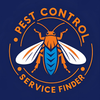Best way to get rid of wasp nest: Safe DIY Guide

Want to get rid of a wasp nest? Grab a stick and knock it down. Sounds easy, right? It's a bad idea. A very bad idea. Figuring out the best way to get rid of a wasp nest doesn't start with a can of spray. It starts with a smart, careful look at the problem. The right approach depends on the wasp, the nest, and where it is. For large or hard-to-reach nests, calling a pro is the only safe move.
If you need a quick, professional opinion on your situation, you can Call +1 855 224 3071 for immediate help.
Understanding Your Wasp Nest Problem
Think a blast from the garden hose is going to solve your wasp problem? Think again. Most people’s first instinct is to grab a spray can or knock the nest down with a stick, but that’s the fastest way to get swarmed and seriously hurt.
The first step isn't to attack—it's to stand back and assess. A wasp nest isn't just a nuisance; it's a major safety hazard. The fear of a painful sting is real, but the danger goes way beyond that. A single nest can be home to hundreds, sometimes thousands, of wasps ready to defend their home. For anyone with an allergy, a single sting can trigger a life-threatening reaction.
The True Scope of the Threat
This isn't just a backyard annoyance; it's a serious global issue. The sheer volume of emergency calls for wasp removal shows just how dangerous they can be.
For instance, a study in South Korea documented a staggering 483,233 emergency calls for wasp nest removal over just five years. In that same time frame, stings from wasps and similar insects led to 78,860 injuries, 49 deaths, and medical bills totaling around $3.2 million USD. You can read the full study on wasp-related incidents to see the data for yourself.
These numbers tell a clear story: underestimating a wasp nest is a bad idea. If you're even slightly unsure about the threat, get an expert opinion. A quick Call to +1 855 224 3071 can connect you with a professional who can assess the risk for you.
Why Wasp Identification Is Crucial
Before you even think about getting rid of the nest, you have to know what you're up against. The best removal method is directly tied to the type of wasp. Different species have wildly different behaviors, nests, and aggression levels.
- Paper Wasps: These guys build those open, umbrella-shaped nests you see under eaves or deck railings. They're usually less aggressive but will absolutely defend their nest if you get too close.
- Yellow Jackets: Notorious for their bad tempers, yellow jackets build large, enclosed paper nests. You'll often find them underground or hidden inside wall voids. Disturbing one of their nests is practically a guarantee you'll be swarmed.
- Hornets: This group includes the formidable Bald-Faced Hornet. They build massive, gray, football-shaped nests high up in trees or on the side of a building. They are extremely defensive and will attack anything they see as a threat.
Identifying the wasp is the single most important action before you decide on a removal plan. Mistaking a highly aggressive hornet nest for a paper wasp nest can lead to a painful, dangerous disaster.
A quick look from a safe distance is your first job. Check out the insect’s size and coloring, and take note of what the nest looks like. If you can't confidently identify the wasp or the nest is in a tricky spot, stop right there. The safest bet is to call for professional help.
For fast guidance on identifying your wasps and getting rid of the nest, Call +1 855 224 3071 to speak with an expert. They can help you figure out the best way to handle your specific problem safely.
Quick Risk Assessment for Wasp Nests
Not sure how serious your wasp problem is? This table breaks down common wasp types to help you quickly gauge the risk. Remember, when in doubt, call a professional.
| Wasp Type | Nest Appearance | Common Location | Aggression Level | Recommended Action |
|---|---|---|---|---|
| Paper Wasp | Small, open-comb, umbrella-shaped | Under eaves, porch ceilings, railings | Low (unless provoked) | Cautious DIY for small, accessible nests. Professional for large or high nests. |
| Yellow Jacket | Large, enclosed paper nest; often has a single, small entrance hole | Underground, in wall voids, attics, hollow trees | High (very aggressive) | Professional removal strongly recommended. Do not attempt DIY. |
| Hornet | Large, gray, football-shaped, enclosed paper nest | In trees, on sides of buildings, in shrubs | High (extremely defensive) | Professional removal is essential. Stay far away from the nest. |
Ultimately, this is a quick guide. Any nest that is large, located in a high-traffic area, or home to a species you can't identify should be handled by a licensed exterminator. Your safety is the top priority. If you need immediate advice, Call +1 855 224 3071 for customer service.
Should You Handle Wasp Nest Removal Yourself
It’s tempting, isn't it? See a wasp nest, grab a can of spray from the store, and solve the problem in five minutes. You save a few bucks and get on with your day. While that sounds great in theory, the reality of DIY wasp nest removal is a whole lot messier and more dangerous.
The truth is, tackling a nest yourself can be the right move, but only in very specific, low-risk situations. For everything else, you’re gambling with your safety. One wrong move can unleash a swarm of angry wasps, leading to dozens of painful stings and a problem that’s suddenly ten times worse. You have to weigh the risks before you even think about it.
Assessing the DIY Risk Factors
Before you grab that can of spray, you need to do a serious risk assessment. Not all wasp problems are the same. A small, visible paper wasp nest hanging from a deck railing is a completely different beast than a huge hornet nest buzzing inside your attic wall.
A few key factors will tell you immediately if a DIY approach is off the table:
- Nest Size and Location: Can you see the whole nest? Is it smaller than your fist and easy to get to? Or is it a monster, tucked high up on a gable or hidden away inside a wall void or chimney?
- Wasp Species: Do you know what you’re dealing with? A fairly chill paper wasp is one thing. A highly defensive colony of yellow jackets or hornets is another entirely.
- Personal Health: Is anyone in your home allergic to insect stings? Even a single sting can be life-threatening for someone with a severe allergy.
This decision tree gives you a quick visual guide on whether to tackle it yourself or call in a pro.
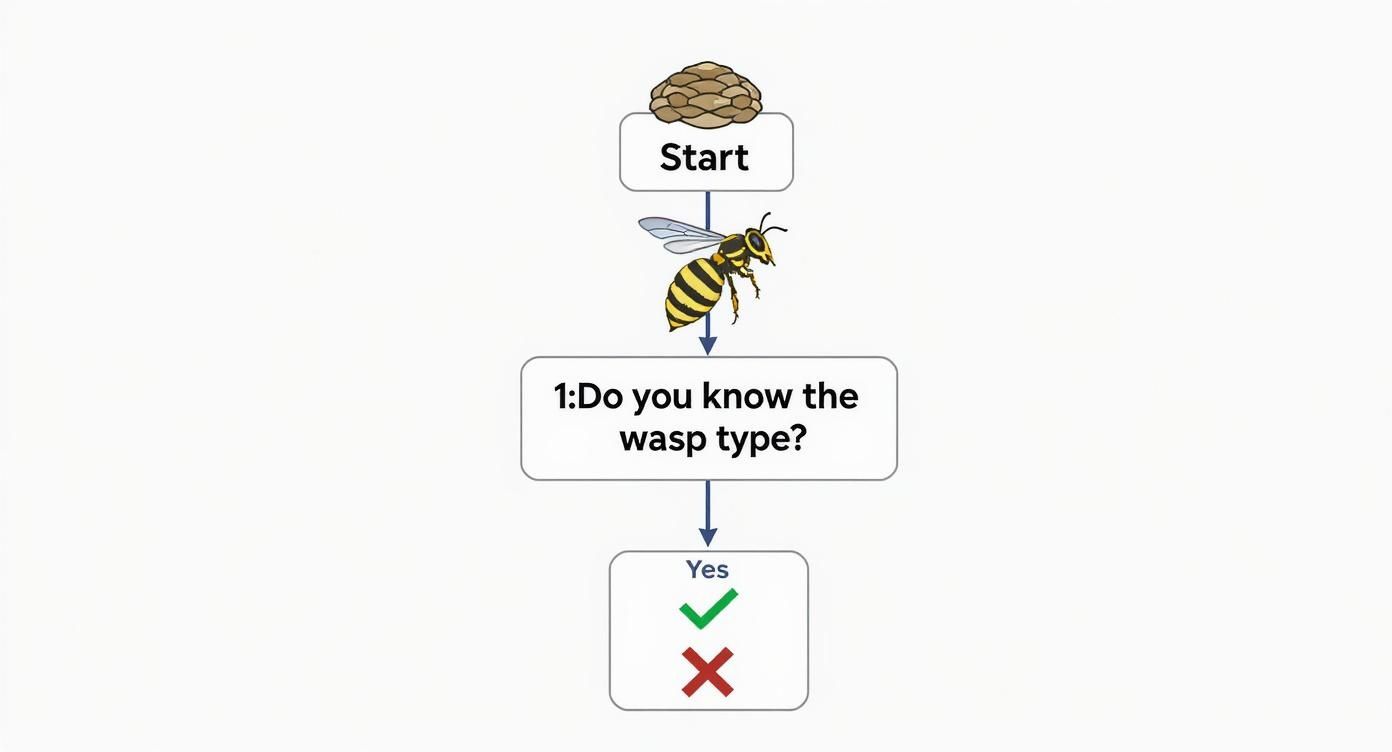
As you can see, any doubt about the wasp type, nest size, or location points straight to calling a professional. For any high-risk situation, the smartest and safest thing to do is Call +1 855 224 3071 for an expert consultation.
The Non-Negotiables: Personal Protective Equipment
If your situation somehow passes that initial risk check, your very next thought needs to be protection. And no, your regular clothes won't cut it. Jeans, a hoodie, and some work gloves are practically an invitation for a wasp's stinger, which can easily poke right through normal fabric.
Proper Personal Protective Equipment (PPE) isn't optional; it's essential.
- Full Bee Suit: This is your most critical piece of gear. It needs to be thick and multi-layered, covering you from head to toe, complete with a veiled hood.
- Thick Gloves: Get non-porous gloves that securely overlap the sleeves of your suit. No gaps.
- Closed-Toe Boots: Make sure your ankles are completely covered and protected.
- Respirator: Some insecticides are nasty if you breathe them in, making a respirator a wise precaution.
Without professional-grade PPE, you're just asking to get stung. So many DIY jobs go wrong because someone underestimated how aggressive wasps get when their home is attacked and didn't wear the right gear.
When you're weighing the costs of buying gear against hiring a pro, it's helpful in understanding the broader DIY vs. handyman debate, as the same logic applies. The potential cost of getting it wrong in pest control is much higher than a crooked shelf.
Timing and Technique Are Everything
Even with all the right gear, your timing has to be perfect. The absolute best time to treat a wasp nest is at night. Wait until well after dusk when the wasps are docile and the whole colony—queen included—is back inside the nest for the night. Trying this during the day is a recipe for disaster.
Before you make your move, plan your escape route. When you're ready, spray the insecticide directly into the nest opening for several seconds and then get out of there immediately. Don't hang around to see what happens.
If things feel like they're getting out of hand, back off immediately and Call +1 855 224 3071. It is always better to admit defeat and let a professional exterminator take over. If you're wondering what separates the pros, check out our guide on the differences between an exterminator and general pest control.
Choosing the Right Tools for DIY Wasp Removal
Think you can just grab any old can of bug spray and go to war with a wasp nest? That's a rookie mistake, and a dangerous one at that. Picking the right tool isn’t just about killing the wasps—it’s about doing it without getting swarmed and stung.
If you’ve sized up the situation and decided it's a low-risk job you can handle, your entire success comes down to what’s in your hands. The wrong product means you might just anger the colony instead of eliminating it. Staring at a wall of options at the hardware store and feeling lost? That’s your cue to stop and rethink. For a quick, professional opinion on what your specific nest requires, you can always call us at +1 855 224 3071.
Insecticides: Foam vs. Spray vs. Dust
When you walk down that pest control aisle, you’ll mainly see three choices: aerosol sprays, expanding foams, and insecticidal dusts. Each one is a specialized tool for a specific job. Using the wrong one is like bringing a hammer to a sword fight.
Aerosol Sprays: This is what most people picture. These cans are built for visible, aerial nests—the kind paper wasps and hornets build hanging from eaves or branches. Their best feature is the range; some can shoot a stream up to 20 feet. That distance is your best friend and your primary safety feature.
Foaming Sprays: Got a nest tucked into a wall void, a crack in the foundation, or some other tight spot? This is your weapon. The foam expands rapidly to seal the entrance, trapping the wasps inside and preventing a full-on counterattack.
Insecticidal Dusts: This is the go-to for ground nests, especially for aggressive yellow jackets. You just puff the dust right into the entrance hole. Wasps coming and going will track it deep into the nest, wiping out the colony from the inside without you ever having to get too close.
No matter what you buy, reading the label is non-negotiable. It tells you everything: the active ingredients, what protective gear you need to wear, and exactly how far away you need to stand.
The Application Process: A Safe Approach
Once you’ve got the right product, your technique is everything. This is where most DIY jobs go horribly wrong. Wasp behavior studies confirm what pros have known for years: timing is critical. Hitting a nest at night, when the wasps are dormant and inside, drastically reduces the odds of an aggressive response. You can learn more about the science behind wasp removal techniques to see why the pros are so strict about this rule.
Before you even think about spraying, plan your escape. Know exactly where you’re going to run after you’ve hit the nest. When it's dark, gear up, approach the nest slowly and quietly, and aim directly at the opening. Spray for the full time recommended on the can, then turn and leave immediately along your pre-planned route. Don’t stick around to watch.
The rule is simple: Spray and run. Your job is to deliver the insecticide and be long gone before the colony knows what hit them. And never, ever use a flashlight—the beam will agitate them instantly.
Non-Chemical Alternatives: Traps and Baits
If you're looking for a less direct method, traps and baits have their place, but you need to understand their limitations. These are not for wiping out an existing, active nest.
Wasp Traps: These use a sweet liquid to lure foraging wasps into a container where they can’t escape and eventually drown. They’re great for reducing the number of random wasps buzzing around your patio or picnic, cutting down the chances of a stray sting.
Baits: Baits work similarly by attracting wasps to a poisoned food source. They carry the slow-acting poison back to the nest, which can help knock down the population over several days or weeks.
Think of traps and baits as population management tools, not nest destroyers. They work best early in the season to catch emerging queens or to supplement a direct attack on a nest. For a closer look at different pest control strategies, check out our guide on do-it-yourself home insect control. But if you have an established colony threatening your home, only a direct treatment will solve the problem for good.
When to Call a Professional Exterminator
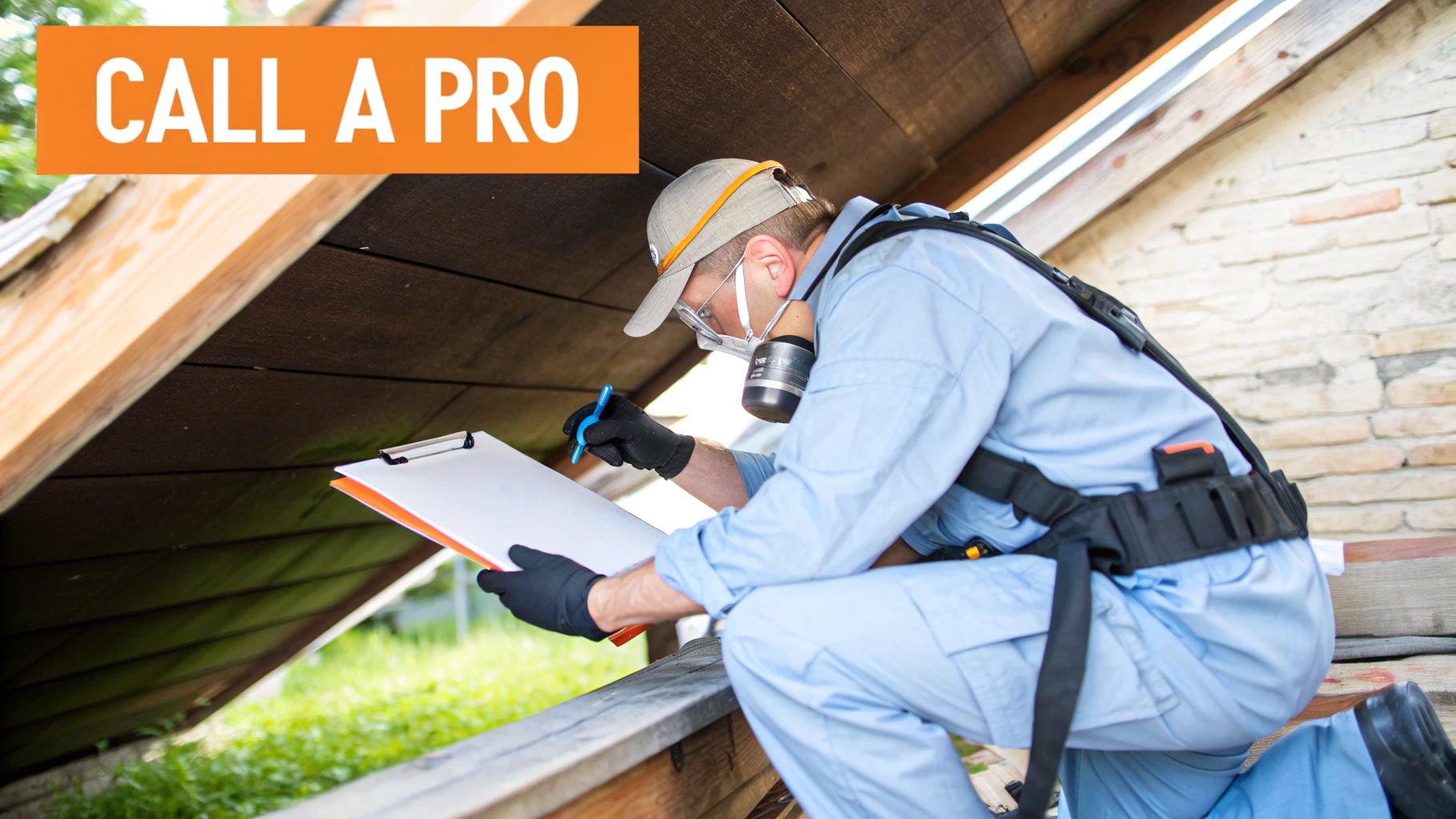
Thinking you’re tough enough to take on a wasp nest? Maybe. But courage has very little to do with a safe outcome here. The most important skill in pest control is knowing your limits.
DIY methods definitely have their place, but there are clear lines you just don’t cross. Recognizing these red flags isn't about admitting defeat—it's about choosing safety over a potential trip to the ER.
If you're on the fence, a quick professional opinion is always a good idea. You can get one by calling +1 855 224 3071.
Clear Signs You Need a Professional
Some situations are immediate deal-breakers for DIY attempts. These aren't just suggestions; they are hard-and-fast rules to keep you and your family safe from a swarm of angry, defensive wasps.
Your first major red flag is nest size. If that nest is any bigger than your clenched fist, the colony is mature and crawling with hundreds, if not thousands, of worker wasps. A population that large can mount an overwhelming, coordinated defense that you are simply not equipped to handle.
Next up is nest location. Can you easily see and spray the entire thing? Or is it tucked away somewhere tricky?
- Inside Walls or Voids: Nests built inside walls, attics, soffits, or chimneys are a professional’s job, period. A can of spray might kill the wasps at the entrance, but it will trap an enraged colony inside your home. They will find a way out, and it will likely be into your living space.
- Underground Nests: Yellow jackets are famous for building huge colonies underground. Kicking at the entrance or pouring gasoline down the hole (a terrible idea) is asking for a world of hurt.
- High Up and Out of Reach: A nest on a second-story eave or high in a tree adds a serious fall risk to the equation. Trying to balance on a ladder while being swarmed by wasps is a recipe for disaster.
If you're facing any of these scenarios, the only safe way to get rid of the wasp nest is to Call +1 855 224 3071 and let a trained technician handle it.
When to Make the Call: DIY vs Professional Removal
Deciding whether to tackle a wasp nest yourself or bring in an expert can be confusing. This table breaks down the key factors to help you make a safe and informed choice.
| Factor | DIY Removal (Low Risk) | Professional Removal (High Risk) |
|---|---|---|
| Nest Size | Smaller than a fist. | Larger than a fist. |
| Location | Easily accessible, visible from a safe distance. | Inside walls, underground, high up, near entryways. |
| Wasp Species | Paper wasps (smaller, less aggressive). | Yellow jackets, hornets (highly aggressive). |
| Allergies | No known allergies in the household or nearby. | Anyone in the home or a neighbor is allergic. |
| Activity Level | Few wasps visible, slow movement. | High traffic, constant stream of wasps. |
Ultimately, if there's any doubt in your mind about your ability to handle the situation safely, calling a professional is the smartest move.
When Species and Allergies Make the Decision For You
The type of wasp you're dealing with is a game-changer. A small paper wasp nest might look manageable, but species like yellow jackets and hornets are notoriously aggressive. They have a much larger defensive zone and will attack in huge numbers with very little provocation. Getting the species ID wrong can be a painful, dangerous mistake.
But the most critical red flag of all is allergies. If anyone in your household—or even a next-door neighbor—has a known allergy to bee or wasp stings, do not attempt DIY removal. The risk of anaphylactic shock is far too high to justify it.
This shift toward professional help is part of a larger trend. Homeowners are increasingly choosing the guaranteed safety and results of an expert over the risks of a DIY project gone wrong. The global pest control market, valued at $24.9 billion in 2023, is expected to hit $32.8 billion by 2028, fueled by this demand for professional services. You can discover more insights about the pest control market to see why expertise matters.
What to Expect When You Call an Exterminator
Calling a pro might feel like a big step, but the process is surprisingly simple and built around your safety. Knowing what happens next can make the decision a lot easier. When you Call +1 855 224 3071, here’s what you can generally expect:
- Step 1: The Inspection: A technician comes out to properly identify the wasp species, assess the nest's size and exact location, and pinpoint any hazards or entry points into your home.
- Step 2: A Clear Plan: Based on that inspection, they’ll walk you through the safest and most effective treatment plan. This could involve specialized insecticidal dusts for wall voids, powerful liquid sprays for exposed nests, or even physical removal.
- Step 3: Safe Extermination: This is where they suit up. Wearing full protective gear, the technician applies the treatment, making sure the entire colony—including the queen—is eliminated.
- Step 4: Nest Removal & Prevention: Once the colony is dead, they will remove the physical nest to keep other pests from moving in. They should also give you advice on how to seal up entry points to prevent it from happening again.
The cost of a professional often ends up being less than a failed DIY attempt, which could include multiple cans of spray, protective gear, property damage, and—worst of all—medical bills. Getting a professional quote is free and ensures the job gets done right the first time.
How to Keep Wasps from Coming Back
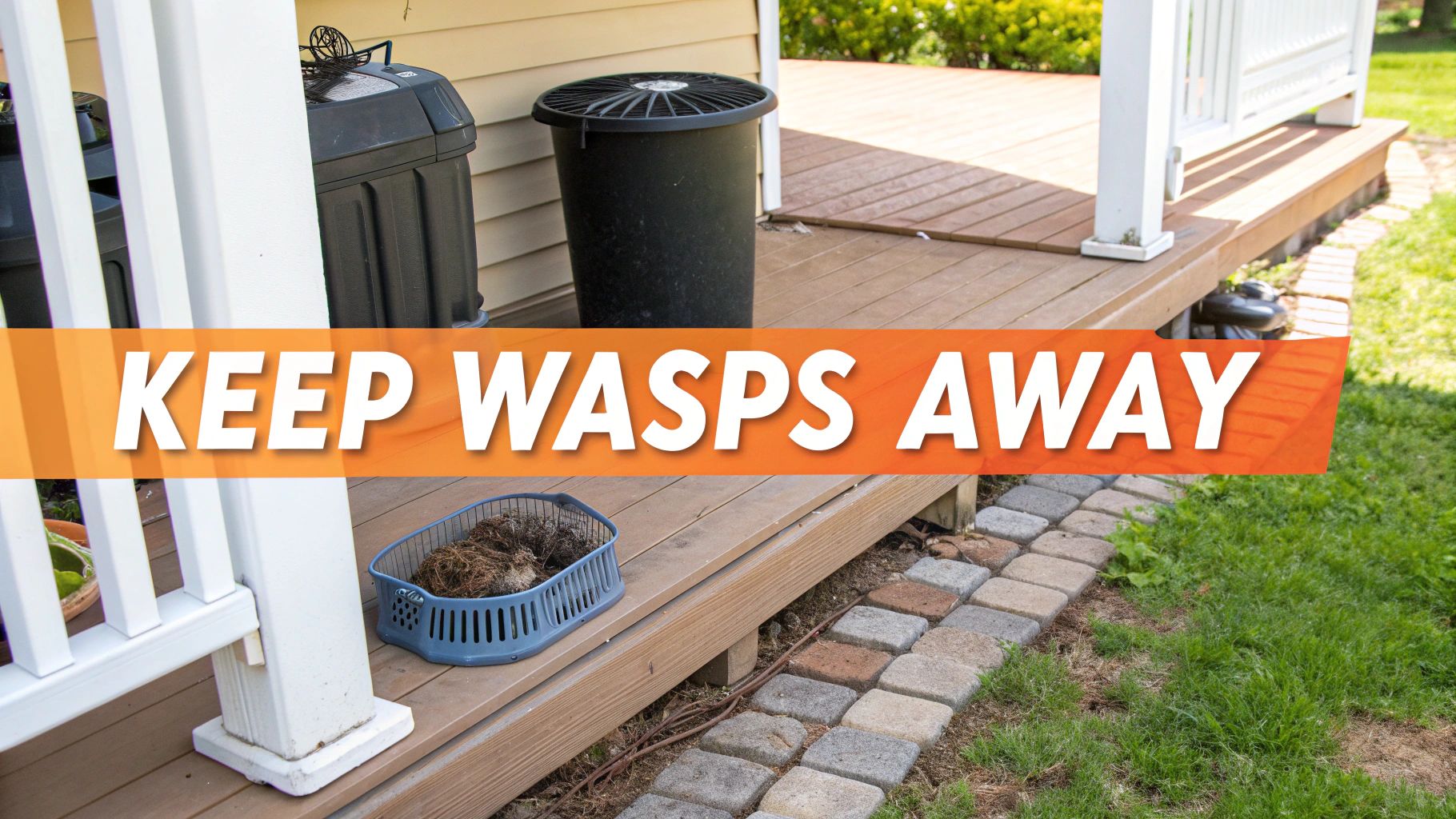
You might think that after removing a wasp nest, the problem is solved. Just knock it down and you're done, right? Not quite. Getting rid of one nest is just the first step. The real victory is making sure a new one doesn’t pop up next season.
This is where the real work begins. Long-term wasp prevention isn't about fighting wasps—it's about convincing them your property isn't a good place to build a home. You need to change your environment to make it far less inviting to these persistent pests.
Aftercare Following Nest Removal
So, the nest is gone. Now what? You have a few immediate cleanup tasks. Even if you've used a powerful insecticide and the nest looks dead, there will be stragglers returning from their foraging trips. These confused and agitated wasps can still be aggressive.
Give it at least 24 hours after treatment before you even think about approaching the old nest site. This gives the insecticide enough time to take care of any returning wasps. Once the area is quiet, carefully scrape off any leftover nest material. Then, scrub the spot with soap and water to wash away any pheromones that could attract other wasps.
Properly disposing of the nest itself is also critical.
- Carefully place the nest and any broken bits into a heavy-duty plastic bag and seal it tight.
- For extra security, put that sealed bag inside another sealed bag.
- Toss it in an outdoor trash can with a secure lid, preferably on the morning of trash pickup.
Creating a Wasp-Resistant Property
The best way to get rid of a wasp nest for good is to make your property an undesirable place for them to build in the first place. This takes a proactive approach that focuses on eliminating the three things that attract them: food, water, and shelter.
Start by sealing up potential nesting spots. Wasps absolutely love protected, hard-to-reach areas.
A single queen wasp only needs a tiny, sheltered crevice to start a whole new colony. By sealing these entry points in the spring, you can stop a future infestation before it even begins.
Take a walk around your property and look for vulnerabilities. Use caulk or sealant to fill any cracks in your home's foundation, siding, and around window and door frames. Check that your vent covers and soffits are secure and don't have any holes. If this sounds overwhelming, getting a professional assessment can help. For expert help identifying weak spots, you can always Call +1 855 224 3071.
Managing Food and Water Sources
Wasps are scavengers. They're constantly hunting for protein in the spring to feed their young and sugary foods in the late summer and fall for energy. Your backyard can easily become their favorite restaurant if you aren't careful.
- Secure Trash Cans: Always, always use trash cans with tight-fitting lids. An overflowing or open can is basically a giant "welcome" sign.
- Clean Up Spills: After outdoor meals or barbecues, wipe up food and drink spills immediately.
- Manage Fallen Fruit: If you have fruit trees, make a habit of picking up any fruit that has fallen to the ground. Fermenting fruit is a massive draw for yellow jackets.
- Pet Food: Don't leave pet food sitting outside for hours on end.
Water is just as important to them. Fix any leaky outdoor faucets and get rid of standing water where wasps might go for a drink. This simple checklist is the foundation of a solid prevention plan. This is a core part of learning what Integrated Pest Management is and applying its principles around your home. For a deeper dive into preventing pest issues, you can explore effective Integrated Pest Management (IPM) strategies to maintain a pest-free environment.
Using Decoy Nests and Repellent Plants
One popular—and surprisingly effective—tactic is using decoy nests. Wasps are fiercely territorial and will almost never build a new nest within 200 feet of an existing one. By hanging a fake nest early in the spring, you can trick a scouting queen into thinking the territory is already claimed, sending her elsewhere.
While it’s not a 100% foolproof solution, a decoy nest can be a great chemical-free deterrent, especially when you use it with other prevention methods.
You can also use your landscaping to your advantage. Certain plants are known to naturally repel wasps. Try planting these around your deck, patio, and other spots where you hang out:
- Mint
- Thyme
- Eucalyptus
- Wormwood
- Citronella
These small, proactive habits can dramatically reduce the chances of another nest showing up next year, saving you a ton of stress. If you do spot a new nest forming despite your best efforts, don't hesitate to Call +1 855 224 3071 for immediate and safe removal.
Common Wasp Nest Removal Questions
When you find a wasp nest on your property, a lot of questions pop into your head. Don't worry, the answers are usually more straightforward than you think and boil down to a few simple safety rules.
Here are the answers to the most common questions we get. If you're dealing with a complicated situation or just want it gone now, expert advice is just a phone call away. Call +1 855 224 3071 for a fast, professional consultation.
What Time of Year Are Wasps Most Active?
Wasp activity is all about the seasons. Knowing their calendar helps you know when to be on high alert and how to prevent them in the first place.
- Spring: A single, large wasp you see scouting around is likely an overwintering queen looking for a place to build. This is the absolute best time for prevention. Taking out one queen stops an entire colony before it starts.
- Summer: The queen is laying eggs nonstop, and the colony explodes in size. Activity hits its peak in late summer as the nest gets crowded. This is when they're most defensive and dangerous.
- Fall: As flowers die off and food gets scarce, wasps get aggressive and desperate. They're the uninvited guests at your picnic, going after sugary drinks and food. The first hard frost of the season will kill off all the workers and males.
- Winter: Only the newly mated queens survive by hibernating somewhere safe. The old nest is abandoned for good.
Will Wasps Go Away on Their Own?
This is the big one everyone hopes for, but the answer is a mix of yes and no.
An active nest will never go away on its own during the spring or summer. It's just going to get bigger, more populated, and more dangerous. The colony will die off naturally after the first hard frost, leaving only new queens to hibernate somewhere else.
The critical thing to remember is that the physical nest structure remains. While wasps won't move back into an old nest, it can attract other pests or give a new queen a perfect foundation to build on next spring.
How Much Does Professional Wasp Removal Cost?
Hiring a pro is an investment in your safety, and the cost can vary. A few key things determine the final price.
Factors Influencing Professional Removal Costs:
| Factor | Description |
|---|---|
| Nest Location | Is it tucked inside a wall, way up on a second-story eave, or underground? Hard-to-reach nests take more work and cost more. |
| Wasp Species | Dealing with aggressive yellow jackets or hornets requires more precautions and specialized gear than handling paper wasps, which affects the price. |
| Nest Size | A softball-sized nest is a much quicker job than a massive, mature nest crawling with thousands of wasps. |
Generally, you can expect to pay anywhere from $150 to $500 for a standard removal. The fastest way to get a solid price for your specific situation is to Call +1 855 224 3071 for a no-obligation quote. An expert can often give you an accurate estimate right over the phone.
Can I Just Knock the Nest Down with a Hose?
Please, don't do this. It’s one of the most common and dangerous mistakes a homeowner can make. Blasting a nest with a hose won't kill the wasps.
What it will do is make them instantly furious. You'll be facing a swarm of angry, wet wasps ready to attack you and anyone else in the vicinity. It’s totally ineffective and practically guarantees you'll get stung—a lot. The best way to get rid of a wasp nest is always with a targeted insecticide treatment or by calling a professional, not with brute force. If you're ever tempted to try the hose method, stop and Call +1 855 224 3071 for a safe and guaranteed solution instead.
When you're dealing with a pest problem, you need fast, reliable help you can trust. Pest Control Service Finder connects you with licensed and insured local exterminators 24/7. Get transparent pricing, no-obligation quotes, and same-day service from vetted professionals who use child- and pet-safe treatments to reclaim your home. Learn more and schedule your service today.
